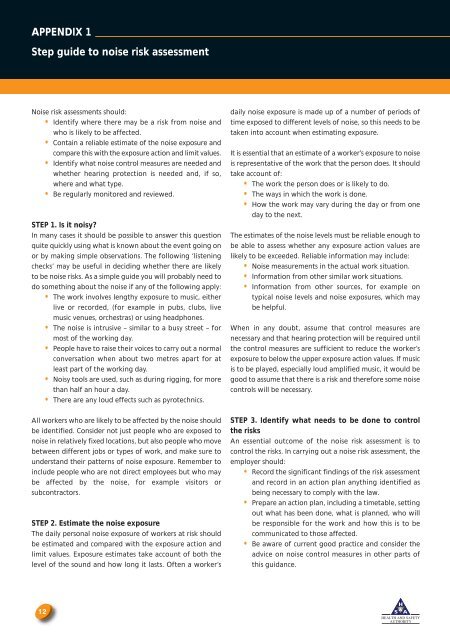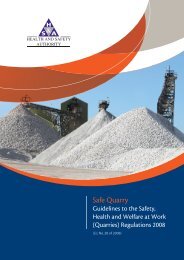The Noise of Music.pdf - Health and Safety Authority
The Noise of Music.pdf - Health and Safety Authority
The Noise of Music.pdf - Health and Safety Authority
You also want an ePaper? Increase the reach of your titles
YUMPU automatically turns print PDFs into web optimized ePapers that Google loves.
APPENDIX 1<br />
Step guide to noise risk assessment<br />
<strong>Noise</strong> risk assessments should:<br />
• Identify where there may be a risk from noise <strong>and</strong><br />
who is likely to be affected.<br />
• Contain a reliable estimate <strong>of</strong> the noise exposure <strong>and</strong><br />
compare this with the exposure action <strong>and</strong> limit values.<br />
• Identify what noise control measures are needed <strong>and</strong><br />
whether hearing protection is needed <strong>and</strong>, if so,<br />
where <strong>and</strong> what type.<br />
• Be regularly monitored <strong>and</strong> reviewed.<br />
STEP 1. Is it noisy?<br />
In many cases it should be possible to answer this question<br />
quite quickly using what is known about the event going on<br />
or by making simple observations. <strong>The</strong> following ‘listening<br />
checks’ may be useful in deciding whether there are likely<br />
to be noise risks. As a simple guide you will probably need to<br />
do something about the noise if any <strong>of</strong> the following apply:<br />
• <strong>The</strong> work involves lengthy exposure to music, either<br />
live or recorded, (for example in pubs, clubs, live<br />
music venues, orchestras) or using headphones.<br />
• <strong>The</strong> noise is intrusive – similar to a busy street – for<br />
most <strong>of</strong> the working day.<br />
• People have to raise their voices to carry out a normal<br />
conversation when about two metres apart for at<br />
least part <strong>of</strong> the working day.<br />
• Noisy tools are used, such as during rigging, for more<br />
than half an hour a day.<br />
• <strong>The</strong>re are any loud effects such as pyrotechnics.<br />
daily noise exposure is made up <strong>of</strong> a number <strong>of</strong> periods <strong>of</strong><br />
time exposed to different levels <strong>of</strong> noise, so this needs to be<br />
taken into account when estimating exposure.<br />
It is essential that an estimate <strong>of</strong> a worker’s exposure to noise<br />
is representative <strong>of</strong> the work that the person does. It should<br />
take account <strong>of</strong>:<br />
• <strong>The</strong> work the person does or is likely to do.<br />
• <strong>The</strong> ways in which the work is done.<br />
• How the work may vary during the day or from one<br />
day to the next.<br />
<strong>The</strong> estimates <strong>of</strong> the noise levels must be reliable enough to<br />
be able to assess whether any exposure action values are<br />
likely to be exceeded. Reliable information may include:<br />
• <strong>Noise</strong> measurements in the actual work situation.<br />
• Information from other similar work situations.<br />
• Information from other sources, for example on<br />
typical noise levels <strong>and</strong> noise exposures, which may<br />
be helpful.<br />
When in any doubt, assume that control measures are<br />
necessary <strong>and</strong> that hearing protection will be required until<br />
the control measures are sufficient to reduce the worker’s<br />
exposure to below the upper exposure action values. If music<br />
is to be played, especially loud amplified music, it would be<br />
good to assume that there is a risk <strong>and</strong> therefore some noise<br />
controls will be necessary.<br />
All workers who are likely to be affected by the noise should<br />
be identified. Consider not just people who are exposed to<br />
noise in relatively fixed locations, but also people who move<br />
between different jobs or types <strong>of</strong> work, <strong>and</strong> make sure to<br />
underst<strong>and</strong> their patterns <strong>of</strong> noise exposure. Remember to<br />
include people who are not direct employees but who may<br />
be affected by the noise, for example visitors or<br />
subcontractors.<br />
STEP 2. Estimate the noise exposure<br />
<strong>The</strong> daily personal noise exposure <strong>of</strong> workers at risk should<br />
be estimated <strong>and</strong> compared with the exposure action <strong>and</strong><br />
limit values. Exposure estimates take account <strong>of</strong> both the<br />
level <strong>of</strong> the sound <strong>and</strong> how long it lasts. Often a worker’s<br />
STEP 3. Identify what needs to be done to control<br />
the risks<br />
An essential outcome <strong>of</strong> the noise risk assessment is to<br />
control the risks. In carrying out a noise risk assessment, the<br />
employer should:<br />
• Record the significant findings <strong>of</strong> the risk assessment<br />
<strong>and</strong> record in an action plan anything identified as<br />
being necessary to comply with the law.<br />
• Prepare an action plan, including a timetable, setting<br />
out what has been done, what is planned, who will<br />
be responsible for the work <strong>and</strong> how this is to be<br />
communicated to those affected.<br />
• Be aware <strong>of</strong> current good practice <strong>and</strong> consider the<br />
advice on noise control measures in other parts <strong>of</strong><br />
this guidance.<br />
12

















